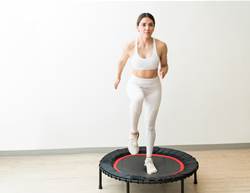A growing body of research confirms what many trainers have long known: strength training is essential for long-term health. And the good news? You don’t need to spend hours at the gym to start seeing results.
New research suggests that just 30 minutes of weight training, twice a week, can lead to measurable gains in muscle strength and size—if you’re consistent.
What did the study find?
A small study published in Medicine & Science in Sports & Exercise followed 42 healthy men and women as they completed a time-efficient strength training program. Participants performed one set of 8 to 10 repetitions per exercise, twice weekly, for eight weeks.
Each session included nine exercises targeting major muscle groups and lasted just 30 minutes. Participants were split into two groups: one trained to failure (lifting until they couldn’t complete another rep with proper form), while the other kept “reps in reserve” (stopped with the ability to do a few more).
After eight weeks, researchers assessed changes in muscle thickness, strength, power and endurance. The results? Everyone improved—regardless of whether they trained to failure or left a few reps in the tank. All participants experienced increased muscle size and strength compared to where they started.
Why might just 30 minutes of weightlifting help?
The Australian Institute of Health and Welfare recommends adults do at least two sessions of muscle-strengthening activity per week, alongside 150 to 300 minutes of moderate-intensity activity. Yet, research shows that many adults aren’t reaching those targets.
That’s why the idea of just two 30-minute weight sessions per week can feel much more achievable—and, according to experts, still worthwhile.
“It doesn’t have to be the most to have a benefit,” says accredited dietitian and strength coach Albert Matheny. “There’s a law of diminishing returns. You get a lot of benefit early on, especially if you’re consistent.”
But don’t confuse shorter with easier. “In our study, the workouts were sufficiently challenging to push participants beyond their current muscular capacity,” says study co-author and an expert in exercise science Professor Brad Schoenfeld. “That kind of stimulus is essential for muscle growth.”
Even brief resistance workouts activate key biological processes: hormone release, mechanical strain on the muscle fibres, and what’s called metabolic stress—a state where the muscle’s normal environment is disrupted, triggering repair and growth.
“These shorter sessions often involve shorter rest periods—around one to two minutes—which increases that metabolic stress,” says clinical associate professor in exercise and nutrition sciences Dr Luke Pryor. That stress, he explains, is part of what cues the muscle to adapt and grow.
And it’s not just beginners who benefit. “This study included participants who were already doing regular resistance training,” Dr Pryor says. “The fact that they still gained strength and size shows that shorter sessions can be effective, even in people who’ve been exercising for years.”
Why does this matter?
The benefits of strength training go well beyond aesthetics. A consistent lifting routine can help increase bone density, which becomes especially important as women age and risk of osteoporosis rises.
“There are also links between strength training and improved hormonal health, longevity and metabolism,” says Matheny.
Schoenfeld adds that resistance training benefits almost every major system in the body. “It improves your ability to carry out daily tasks, supports mental health, enhances cardiovascular function and lowers injury risk,” he says. “It’s one of the most effective, accessible ways to maintain long-term health.”
How to maximize your weightlifting time
If you’re starting a strength training routine, it’s worth allowing a little extra time upfront to get familiar with the equipment and proper form. “You’ll need to spend some time figuring out the right weight to use so that each exercise actually challenges your muscles,” says Matheny.
In the study, participants worked through nine key exercises targeting all major muscle groups:
- Front lat pull-down
- Seated cable row
- Shoulder press
- Chest press
- Cable triceps pushdown
- Supinated dumbbell biceps curl
- Smith machine squats
- Leg press
- Leg extension
But Matheny recommends beginners start with exercises that use multiple large muscle groups—also known as compound movements. These recruit more muscle fibres, burn more energy and can help you see results faster.
Try building your routine around these foundational moves:
- Push-ups
- Squats
- Lunges
- Deadlifts
- Pull-ups or assisted pull-ups
“Studies often use smaller, isolated movements like triceps pushdowns because they’re easier to measure,” says Matheny. “But multi-joint exercises give you more return for your effort.” Dr Pryor agrees: “You want movements that work a lot of muscle at once.”
Schoenfeld adds that reducing rest time between sets can also enhance results. “Keeping rest intervals under two minutes helps you get more done in less time,” he says. But ultimately, the best exercises are the ones you’ll actually stick with. “Personal preference should guide your routine,” Schoenfeld says.
And if 30 minutes still feels like a stretch? That’s okay too. “Even 20-minute sessions can deliver results,” says Dr Pryor. The key is consistency—not perfection.









